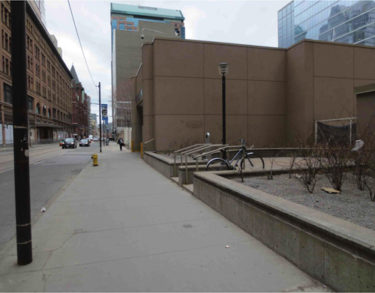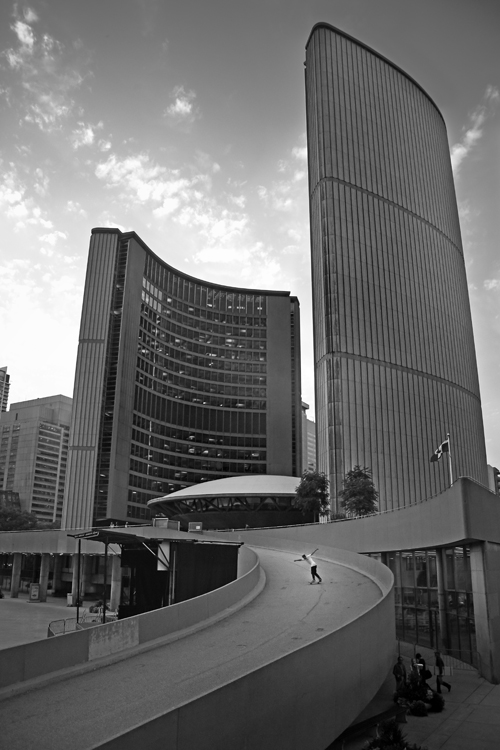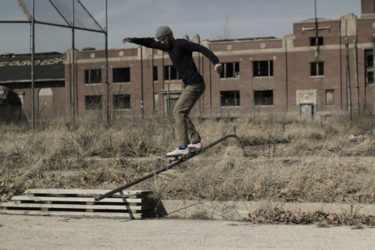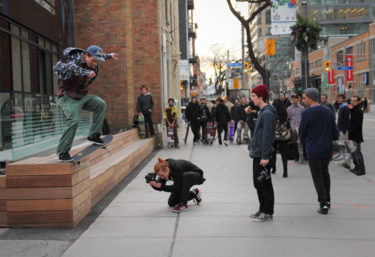Re-imagining the Landscape: Skateboarding as somatics
TEXT BY ARIEL STAGNI
“Two hundred years of American technology has unwittingly created a massive cement playground of unlimited potential, but it was the minds of 11-year- olds that could see that potential.”—Craig R. Stecyk III

As a skateboarder, I am familiar with the many ways that space is controlled. Exploring public and private property as a teenaged skater, I learned how it felt to be “othered.” I’ve been asked to leave countless places, banned from office towers and shopping malls, and criminalized for skateboarding in parking lots, streets, and sidewalks. Across North American municipalities, it is not uncommon for governments, land owners, and property managers to post signs stating that skateboarding is not allowed. In Toronto, I’ve watched teenaged skaters get handed tickets and fines by security guards and police officers for trespassing.
With the growth in popularity of skateboarding in the 1990s, my friends and I got our first glimpse of defensive architecture that targeted skateboarders. We initially noticed that aftermarket “accents” (also known as skate stoppers, caps, blocks, notches, spikes, planters, etc.) were added in urban settings to ledges, benches, and handrails. A more recent trend has these and other anti-skateboarding features built right into original designs.
Despite all the signals we receive about how spaces are not to be used, our belief in skateboarding, coupled with our commitment to finding and creating places to skateboard, compels us to question and challenge social norms by exercising our ideas of how spaces could be used.
Consider the photo above. What do you see?
As a skater, I see smooth ground, a waxed concrete ledge that looks like it is a healthy height for a grind or slide. And I want to jump over that fire hydrant and explore some tricks I’ve been playing with. Simply put, I see opportunities!
If you’ve ever been on a skateboard, maybe you, too, are familiar with the sense of playfulness and freedom that can happen there. Getting onto a skateboard demands your immediate and undivided attention. It simultaneously invites and requires you be present.


When I step onto my skateboard, I’m reminded of the potential of this tool, and I want it to feel like an extension of my body. At once, I search for resistance between the soles of my shoes and the griptape of my skateboard, and my toes and the edges of my feet tell me where I’m positioned on my skateboard. My curiosity blooms and I begin to explore my surroundings. As I move in space, I find equilibrium in my movements, and the work of my muscles turns to ease of movement. Tapping into my body’s awareness is a requirement for not falling off, and that natural high is a big reason why people get back onto their skateboards. As I scan my body, my sensors are open and my body buzzes as I process new information. As a skateboarder in this state, I collect and instantly process feedback about changes in slope, elevation, materials, and textures. I am hyper-aware and able to focus intently. On my skateboard, I can experience countless moments in which the world slows, background noise drops away, and what shines through is a highly efficient experience of being. It is potent, captivating, and exhilarating. This is the zone athletes achieve when the universe and the components of their training align. In this mindfulness practice, this present moment is the one that matters. Worldly thoughts get sidelined, and, recognizing that this feeling is fleeting and may be immediately followed by pain, living in the moment feels all the more salient. Could the quality of our spaces benefit from a similar embodied presence/kinesthetic exercise like the one described above? What if all spaces were considered mindfully in the design phase?
Kinesthetic exploration on a skateboard is as much about somatics as it is about engagement with physical surroundings. In this way, skateboarding is also about responding to the built environment and re-imagining what is found there.

Skaters begin with a utilitarian approach, and wonder, “How can I make immediate use of this space?” To see through commonly accepted rules about how spaces should be used, skaters carry a powerful lens that helps identify opportunities. To distinguish such opportunities requires creativity and playfulness. This compulsion happens on and off our skateboards, which means that skaters are always exploring and analyzing the built environment. We skate benches, ledges, flat surfaces, embankments, parking blocks, handrails, curb cuts, bumps, stairs… There is almost no distance we won’t go to imagine, find, or make a novel experience on our skateboards. This unstructured play can take place almost anywhere, and it often adds life and activity to unused or underused spaces.
This approach is relevant and bold in a world subscribing to all the ways we shouldn’t use spaces. Skaters choose to ignore the dominant, single story of how spaces should be used, and, in this manner, skateboarding offers a criticism of how spaces are designed and used. Not only does skateboarding challenge the status quo, it also adds diversity of use. Seeing and using space differently is a practice in problem-solving and seeing alternatives. This practice builds capacity in people to re-imagine options, which adds resilience in their communities. What if we chose to shift our focus from controlling the use of space to valuing the practice of imagining the use of space? Skateboarding is one example of beauty that can emerge when we move beyond our single story of how to use space. What if spaces were designed to welcome a multiplicity of uses including ones that re-interpret how spaces can be used? What other magic is waiting to emerge?

BIO/ ARIEL STAGNI IS AN AVID SKATER WHO BELIEVES IN SKATEBOARDING AS A TOOL FOR YOUTH ENGAGEMENT AND COMMUNITY DEVELOPMENT. HE HAS WORKED ON MORE THAN 50 SKATE-PARK PROJECTS ACROSS ONTARIO AND CONSULTS ON ALL ASPECTS OF SKATE-PARK DEVELOPMENT AND RELATED PROGRAMMING.
